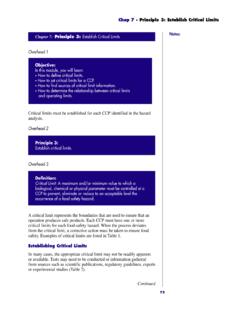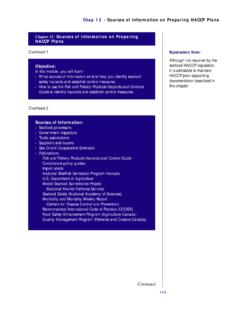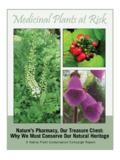Transcription of Chapter 2: Hazards - Biological, Chemical and Physical
1 Chap 2 - Hazards - biological , Chemical , and Physical Chapter 2: Hazards - biological , Chemical and Physical Overhead 1 Explanatory Note: Whether a particular hazard Objective: listed in this Chapter will need Awareness of: to be addressed in a HACCP. biological Hazards plan will depend on an Chemical Hazards evaluation of the actual risk Physical Hazards and severity of the hazard in Characteristics of certain microorganisms the food. This evaluation is explained in the next Chapter . To perform a hazard analysis for the development of a HACCP plan, food This Chapter is intended as a processors must gain a working knowledge of potential Hazards . The general discussion on HACCP plan is designed to control all reasonably likely food-safety Hazards . For information on Hazards . Such Hazards are categorized into three classes: biological , seafood-specific Hazards , Chemical and Physical . refer to Appendix III. Overhead 2 Additional information on potential Hazards for specific types of seafood and process- Definition: ing methods is found in the Hazard: a biological , Chemical or Physical agent that is reasonably FDA "Fish and Fisheries likely to cause illness or injury in the absence of its control.
2 Products Hazards Control Guidance" referenced in Chapter 13. biological Hazards include harmful bacteria, viruses or parasites ( , salmonella, hepatitis A and trichinella). Chemical Hazards include compounds that can cause illness or injury due to immediate or long-term exposure. Physical Hazards include foreign objects in food that can cause harm when eaten, such as glass or metal fragments. It is important to understand that, for the purposes of HACCP, Hazards only refer to the conditions or contaminants in food that can cause illness or injury to people. Many conditions are highly undesirable in food, such as the presence of insects, hair, filth or spoilage. Economic fraud and violations of regulatory food standards are equally undesirable. All of these defects must be controlled in food processing. However, they often are not directly related to the safety of the product. Unless these conditions directly affect food safety, they are not included in a HACCP plan.
3 Continued 11. Chap 2 - Hazards - biological , Chemical , and Physical Notes: Overhead 3. In HACCP, " Hazards " refer to conditions or contaminants in foods that can cause illness or injury. It does not refer to undesirable conditions or contaminants such as: Insects, Hair, Filth, Spoilage, Economic fraud and Violations of regulatory food standards not directly related to safety. It is not within the scope of this course to go into detail on foodborne Hazards . That topic is too large and would be covered better in separate microbiology, toxicology and food-processing courses. However, this Chapter will increase awareness of the kinds of Hazards that may occur in foods. This awareness will prepare participants for recognizing what is and is not appropriate to control with HACCP. Food processors may find it necessary to work with technical experts to develop a HACCP plan. biological Hazards Foods can contain biological Hazards . These Hazards can come from raw materials or from food-processing steps used to make the final product.
4 Table A (at the end of the Chapter ) provides a list of biological Hazards . Microorganisms Organisms too small to be seen with the naked eye are called microorgan- isms. Microorganisms live everywhere: air, dirt, fresh and salt water, skin, hair, animal fur and plants. Microorganisms are classified into various groups. A few groups important in foods include yeasts, molds, bacteria, viruses and protozoa. Since microorganisms are so widespread, it is important to understand when to be concerned about them and how to deal with them. Although thousands of kinds of microorganisms exist, only a few pose Hazards to humans. These hazardous microorganisms, or pathogens, will be discussed in more detail later. Many microorganisms are beneficial. Certain kinds of yeast, molds and bacteria help make cheese, sour cream, yogurt and other fermented dairy products. Particular kinds of yeast are used in making beer, wine and other fermented beverages.
5 We add these microorganisms to our foods intentionally, and they cause no harm. In fact, studies show that some of these microorganisms contribute to good health. 12. Chap 2 - Hazards - biological , Chemical , and Physical People may come into contact with thousands of kinds of yeasts, molds, Notes: bacteria, viruses and protozoa daily without ill effect. Therefore, when foods are processed and preserved, food processors and regulators need only be concerned with some microorganisms, particularly pathogens. Overhead 4. Microorganisms can be beneficial, even essential. Some can be pathogenic. It is this class that concerns food processors and public health officials. Although microorganisms are too small to be seen without a microscope, they are alive and have certain needs to live and grow. Without adequate food, water and temperature, microorganisms stop growing and multiply- ing. Some die; others stop functioning until they get the elements they need.
6 Some preservation methods, such as drying or smoking, control the water or nutrients in food, making these essential elements unavailable to microorganisms. Overhead 5. What do microorganisms (other than viruses) need? Food Water Proper temperature Air, no air, minimal air Different microorganisms respond differently to air. Like most plants and animals, many microorganisms need air to live and will die or stop growing if deprived. However, many microorganisms can function without air. Some are poisoned by it. Unfortunately, pathogens exist in each of these categories. Although some microorganisms can be con- trolled by the amount of air they receive, it is not an effective way of controlling all pathogens. Microorganisms multiply in different ways. The most common method, especially for yeasts, bacteria and protozoa, is to grow large and divide. One microorganism splits into two, two into four, four into eight, eight into sixteen, and so on.
7 By doubling, microorganisms multiply quickly. Under ideal conditions, some bacteria double every 20 minutes. Potentially, one microorganism can multiply to more than 30,000 in five hours and to more than 16 million in eight hours. Fortunately, most microorganisms grow more slowly than this, and we can slow them even more by controlling the food, water and temperature that they need to grow and multiply. Continued 13. Chap 2 - Hazards - biological , Chemical , and Physical Notes: Overhead 6. Many pathogenic microorganisms reproduce by dividing in two: When they grow, microorganisms produce by-products. Yeast bread, beverages, fruit Lactic acid bacteria yogurt, cheese, meats Staphylococcus aureus enterotoxin Most spoiled foods do not present a health risk, and not all food that appears normal is safe to consume. When microorganisms grow, they often produce by-products. The more they grow, the more by-products they produce. Some of the by-products are desirable in the right foods.
8 For example, when yeasts grow in dough, they produce carbon dioxide, acids and flavors. The dough rises and we make bread. However, when the same yeasts grow and produce the same by-products in another food, such as fruit juice, it may not be desirable. Then we call it spoilage. Such spoilage is undesirable, and processors strive to avoid it in food. In addition, some by-products produced by pathogens are toxic and can cause disease. Overhead 7. Food spoilage or decomposition that can result in a food-safety problem should be prevented or controlled by a HACCP program. Spoiled food may not look, smell or taste good, but only food spoiled by pathogens or contaminated by toxic microbial by-products can make a person sick. Food spoilage or decomposition that can result in food-safety problems should be prevented or controlled by a HACCP program. During the processing of foods, the amounts and types of microorganisms can be increased, held constant, reduced or destroyed.
9 Even though processing can be used to destroy harmful microorganisms, many safe microorganisms can survive the treatment and continue to live. Example: Milk is pasteurized, or heat-treated, to destroy pathogens. After pasteurization, milk is safe to drink even though nonpathogenic microorganisms survive. 14. Chap 2 - Hazards - biological , Chemical , and Physical Overhead 8 Explanatory Note: Students may ask why some Microbiological Hazards include harmful: Hazards are classified as Bacteria, Chemical rather than Viruses and biological . The best answer is Protozoa tradition. It is important to stress, however, that the significant issue is not the Among the five groups of microorganisms described earlier, only bacteria, actual classification of a viruses and protozoa include the kinds of microorganisms that can make hazard, but accurate food unsafe. Generally, yeast and molds do not pose a biological hazard in identification and control.
10 Food. Some molds produce hazardous toxins, but these toxins are consid- ered Chemical Hazards . Overhead 9. Bacterial Hazards : Food infection and food intoxication Sporeforming and nonsporeforming bacteria Bacterial Hazards Bacterial Hazards are defined as those bacteria that, if they occur in food, may cause illness in humans, either by infection or intoxication. Food- borne infections are caused by swallowing live pathogens that grow within the body, usually in the intestinal tract. They differ from food-borne intoxication, which is a condition caused by swallowing preformed toxins ( , toxins produced by microorganisms in the food before it is eaten). Bacterial Hazards can also be grouped into sporeformers and non- sporeformers. Certain types of bacteria ( , Clostridium and Bacillus spp.) pass through a dormant stage in their life cycle called a spore. Although the microorganism exists as a spore, it is very resistant to chemicals, heat and other treatments that would normally be lethal to nonsporeforming bacteria.








